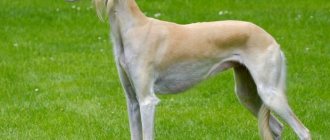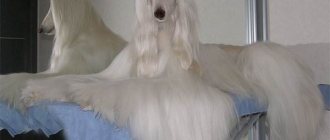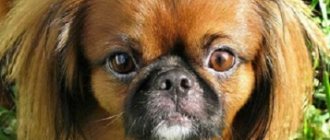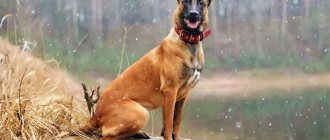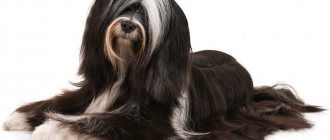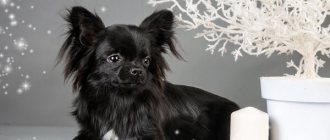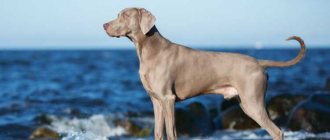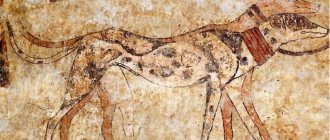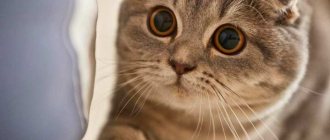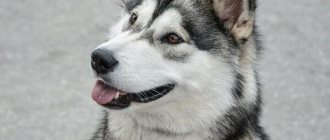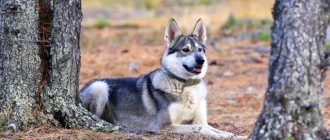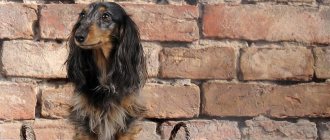Description and breed standard
Male height at withers: 58-71 cm
Height of the bitch at the withers: proportionally less
Weight: 15.8-32 kg
Color: any colors and combinations are allowed, however, brindle color is extremely undesirable and points will be reduced for it at shows.
additional characteristics
The length of the body from the shoulders to the base of the tail should be approximately equal to the height at the withers, otherwise the dog will appear disproportionate.
The standard specifically states that the appearance of the animal must be noble . It is also specifically stated that movements should be swift, but graceful, and it should not be noticeable that the dog is making an effort.
The Saluki's coat There are long-haired and short-haired Salukis; the former have a kind of “fluff” of wool on their legs and head (and sometimes on their chest). They also have fluffy ears.
The nose is black or liver brown, the eyes are very dark to hazelnut colored, large and oval.
Kinds
Arab nomads developed several varieties of Saluki. In character they are not much different from each other. The main criterion for difference was the type of coat. One type of breed, the mountain one, has very delicate long hair, while the second, the desert type, on the contrary, has rough and short hair.
The second type of breed differs from the first in its small stature, 10-13 cm shorter.
Regardless of the Saluki type classification, it has a lean body with a clearly visible skeleton, especially on the belly. An inexperienced person can say about such dogs that they are hungry. This is not true. Thinness is a feature of many hound breeds. The exterior of this dog allows it to catch up with prey on almost any terrain, firmly holding it with its teeth until the owner arrives.
History of the Saluki
Most dog experts agree that this is the very first domestic dog breed . Most likely, the breed originated in the territory that ran from Ancient Egypt along the Mediterranean coast and ended in Mesopotamia on the shores of the Persian Gulf. These were the most fertile lands in the region.
The most capable dogs were bred. Since the poor worked in the fields and pastures to feed their masters, those who could afford to go hunting were engaged in divorce. At first they hunted for food, but then it became elite entertainment, which immediately raised the price of the dog.
“Wedding in Cana”, 1562-1563, artist Paolo Veronese. The Saluki can be seen in the center of the canvas.
It is known for certain that in 329 BC. Alexander the Great himself kept Salukis and even took his pets on his campaign to conquer India. The Arabs used the breed to herd the gazelle, the fastest of all antelopes.
Presumably this particular breed was depicted on the inner walls of Egyptian pyramids dating back to 2000 BC. e.
Recently, researchers announced that mummified dogs found in the pyramids are also the ancestors of the breed. But the burials date back to the 6th millennium BC. e.!
In the Middle Ages and the Renaissance, European monarchs became interested in the breed. For example, the Duke of Saxony Henry IV (1473-1541) is depicted in one of the frescoes with his pet.
Henry IV of Saxony, artist Lucas Cranach
“Praise of the Magi”, 1573, artist Paolo Veronese. Saluki in the lower right corner.
In the 1840s, the breed came to England, which then set the tone in cynology. The British developed an interest in the Middle Eastern breed, which coincided with the discovery of Tutankhamun's , where drawings of these dogs were also found. To the credit of the British, they respected the characteristics of the Saluki and bred them in accordance with the rules adopted in Arab countries.
In the 20th century, all federations gradually recognized the Saluki as a separate breed; now single-breed exhibitions are held on all continents except Antarctica.
Salukis are classified as greyhound dogs . The latest version of the standard was adopted in 2000.
Additional Information
Royal dog of Egypt. The Egyptian nobility considered the breed a valuable and honorable companion, and dogs were known to be mummified in the manner of Egyptian pharaohs. The remains of Persian greyhounds have been found in tombs on the upper Nile.
Self-sufficient dog. Salukis are part of the greyhound group. When hunting, greyhounds rely only on their eyesight. They track prey with their eyes and catch it at lightning speed. People can't keep up with these fast dogs, so the dogs work alone. Because of this feature, the Saluki's character is extremely independent.
Deceptive vulnerability. Salukis look very fragile, graceful and weak. Few people know that these dogs are capable of reaching speeds of about 50-70 km per hour, and some individuals can run at a speed of 90 km per hour. The Saluki is considered one of the fastest dogs in long distance racing. In addition, the Persian Greyhound is famous for its endurance and ability to work in almost any climatic conditions.
Webbed feet. Salukis have special membranes between their toes that allow them to run freely on sticky sand.
Character and temperament
This breed definitely has its own opinion, although its entire life is devoted to its owner . Moreover, they become attached to one person in the family. Yes, the Saluki will be friendly to everyone, and will even obey, but you should not be mistaken about it: it will immediately choose the one who will become its true owner, and will be completely devoted only to him.
They are very tactful ; they will even accompany their beloved owner like a shadow, but will not persistently seek his attention through active actions.
It is very important for this breed that its owner is the leader of the entire “pack”, then it will feel comfortable and confident. A Saluki will not show aggression towards people if it is not threatened.
They do not really like games that other dogs enjoy; for example, if they bring a thrown ball to their owner, it will be on command and without any pleasure.
Salukis do not like to be bored or stay at home alone for a long time. If this pet gets bored, it can have disastrous consequences for the home.
Distinctive features
Arabian Greyhounds must meet the parameters set by the FCI standard. Basic requirements of the regulatory document:
- The head is narrowed, of pronounced length, has a noble and graceful appearance . The forehead is not convex, the stop is almost invisible.
- bite . The jaws are strong, the teeth are complete.
- The lobe is black or brown.
- The eyes are oval-shaped, large, but do not give the impression of being bulging. The color of the iris varies from walnut tone to dark and rich. The look is meek, but emphasizing one’s own dignity.
- The neck is muscular, elongated, graceful.
- The ears are of pronounced length and are distinguished by a high set. At rest they are adjacent to the muzzle, in other cases they are mobile.
- The tail is low set, reaching to the hock joint or below. Slightly curved, creates a natural impression. Usually does not rise above the line of the spine.
- The torso is square in shape, but due to the thin physique and strongly toned abdomen, a feeling of elongation is created. The sternum is stretched in length, not flat. The ribs are clearly visible. The wide back goes into a slightly arched lower back.
- Legs are straight, powerful, with developed thighs and shins. The pasterns are flexible, have a slight slope, the shoulder blades are set back, the same length as the shoulders. The paws are medium-sized, flexible, with elongated toes, between which there is thick hair.
- The movements are light, without raising the forelimbs, and turn into a trot.
- The coat is presented in 2 variants : completely smooth and type with feathering. In any case, the hair is soft and shiny. Feathering in adult Salukis is present on the limbs, back of the thigh, and throat. Long hair covers the ears and the lower part of the tail.
Dog and man
This is not to say that the Saluki is suitable for keeping in an apartment. Like any hunting breed, it needs to realize its irrepressible energy. The best place to live would be a house with a fenced yard . The fence must be high.
Since the popularity of hunting, especially in European countries, has fallen, the Saluki is gradually transforming into a companion dog without losing its excellent physical shape. She has attracted many people with her devotion and will be able to become a family dog. At the same time, you must always remember that she will adore only one person , and just treat the rest well.
By the way, when choosing this breed, you should carefully evaluate your willingness to spend her entire life with her: the Saluki will not be able to accept a new owner , she will remember the first owner, and this will affect her behavior and mood.
With children, this dog will be careful and restrained, but will not allow any pinching or kicking in its direction. Rest assured, she will respond, not necessarily with a bite. She may growl and bark loudly, although the possibility of biting cannot be completely ruled out. Therefore, this breed is recommended for those whose children have already grown to a more or less conscious age.
The Saluki is not very suitable for older people, as it requires a lot of physical activity and a firm hand when training. However, if you are full of life, then this pet will only add color to it.
Salukis are favorable towards representatives of their breed and can accept another dog. There were cases when these pets got along with cats, but in this case the cats were the first pet in the family.
Important: do not risk having any small pets after this swift beauty has appeared in your home. Its hunting instinct cannot be suppressed by any training. That's why cats, rabbits, ferrets, guinea pigs and chinchillas are taboo!
Theses
- They love to run and need daily activity.
- But you need to walk them on a leash, unless you are convinced that the area is safe. The Saluki has a strong instinct that makes it chase animals.
- They love family, but do not trust strangers. Early socialization is important to eliminate fearfulness and timidity.
- It is necessary to provide a comfortable bed, since the dog does not have enough fat.
- For older children they can be friends and comrades, but for little ones they are not recommended.
- Rarely voice.
- When training a Saluki, you need to be consistent, persistent and use only positive methods.
- They should not be kept in a home with small pets. Sooner or later the end will come.
- They can be picky eaters.
Maintenance and care
Salukis should only be walked on a leash . Even the strictest upbringing will not stop her if she sees an animal that she regards as prey. At the same time, she does not notice anything, not even speeding cars. If you let her go into the yard of your house, then check if there are any loopholes, otherwise, if she sees a squirrel or cat, the Saluki will chase it.
This breed needs a long walk and, preferably, free range. She will keep herself in shape.
Saluki owners are often asked the question: “Do you even feed your dog?” . Don't pay any attention to him. Yes, the Saluki will have visible ribs . This breed eats and drinks little, moreover, they are picky eaters and will not eat everything that is given to them. Arabian breeders, who are recognized as the most experienced, provide Salukis with natural food. Their menu includes:
- Veal and lamb;
- Chicken and turkey;
- Fish;
- Solid vegetables: carrots, beets, celery, cabbage stalks, pumpkin;
- Unsweetened fruits: apples, pears (citrus fruits should not be given);
- Sometimes dairy products: natural yoghurts and cottage cheese;
- Boiled eggs 2-3 times a week;
- In addition, breeders from Arab countries believe that this breed does not need grains .
It is better to feed your dog in small portions: Salukis have a high metabolic rate. You can always choose dry food, but then it is better to choose expensive varieties and the type of food that is suitable for active animals.
The Saluki is a clean dog and has virtually no odor. She avoids puddles and dirt in every possible way during walks; she needs to be washed if she gets dirty. Brush your Saluki once a week to remove loose hair and distribute skin oils. Periodically you will have to trim your nails and keep your ears clean. Your dog needs to brush its teeth twice a week.
This breed does not tolerate cold weather , so for winter walks you need to buy warm overalls. The owners of these dogs recommend insulating her sleeping place : life there should be cozy and warm, regardless of the time of year.
Estrus
- age of onset of the first estrus in a female is 6-12-14 months;
- duration of estrus is 20-22 days, sometimes up to a month;
- frequency of estrus – 1-2 times a year with an interval of 6-9 months;
- signs of estrus – swelling of the dog’s external genitalia, spotting;
- frequent urination - having to walk more often than usual;
- psychological signs - a change in the dog’s behavior - from aggressive to lethargic;
- perhaps there is a change in appetite and the dog drinks more water;
- often bitches begin to shed before going into heat;
- lick the loop intensively.
You can notice the approach of estrus while walking your dog. Behavior can change, often the dog becomes active, playful and disobedient, or, on the contrary, looks unhappy and lethargic. The bitch makes frequent marks - scent “lures” for male dogs, and urination occurs more frequently. The loop becomes more and more swollen; when pressed, you can see a discharge of light pink or dull pink color. If you notice changes in the dog's behavior, do not be lazy and check the dog every day for the onset of heat by dabbing the bitch's loop with a napkin or toilet paper. Pinkish discharge will be the beginning of estrus - mark this day in your dog’s notebook.
The course of the dog's first heat.
- The first heat in dogs is not the same as the next one.
- It may be shorter or longer than the usual estrus period.
- The bitch has either only weak manifestations of estrus, or, conversely, very heavy discharge.
- The first heat may suddenly stop, and then after some time begin again.
- There may be mucous discharge from the loop, a smell that attracts males, and the estrus itself will begin after some time.
- Try not to miss the start time of the first, and subsequently the second estrus, in order to correctly determine the intervals between estrus and know their timing and duration.
Precautions during estrus. If you are not interested in getting puppies from your dog, you need to take the following precautions during heat:. If you are not interested in getting puppies from a dog, you need to take precautions during heat:
If you are not interested in getting puppies from a dog, you need to take precautions during heat:
- walk your dog ONLY on a leash: even the most obedient dog these days can simply run away, not paying attention to commands;
- do not allow male dogs to mount the dog: if sexual intercourse begins, it is almost impossible to separate them;
- during a walk, literally DO NOT take your eyes off the dog, even when buying bread in a tent, eliminate or minimize contact with male dogs;
- there is a danger of the dog catching a cold in the cold season, the best way to protect yourself is not to walk for a very long time in cold weather and use dog clothes;
- If your dog lives freely on your territory, then from the moment the estrus begins, lock the dog in an enclosure.
Training and baiting
It is typical for Salukis to test their owner's strength before submitting. This is a very proud breed, and it will only obey its leader. Therefore, when she resists, you must be persistent, but not cruel. Saluki often plays a game of “who will out-stubborn whom.” Once she understands that you are a leader, there will be no problems with obedience.
However, no one can suppress her instincts and forbid her to run after the “prey”.
start socializing your dog immediately after the second vaccination and subsequent quarantine. Over the course of a month, try to show her to as many people as possible. Let her smell new smells and see unfamiliar places.
Saluki does not require baiting when hunting antelope, hares, foxes and other animals - natural instinct will work. This breed needs training if you suddenly decide to hunt a wolf with it, this is explained by the too close genetic connection between wolves and greyhounds.
This baiting begins at one year of age . The wolf is taken to a field and released there. The hunter must bring an experienced huntress to accompany the young greyhound. When she chases a predator, the inexperienced dog will begin to copy the behavior of her friend.
If the Saluki, during 2-3 training sessions with an experienced hunter, cannot show healthy anger towards the wolf and capture it correctly, then the dog is not suitable for such a hunt.
Dossier
Adult height: 48 – 71 cm. Weight: 18 – 27 kg. Characteristic color: white, gray, fawn, red, black and tan, piebald, except brindle and albino. Coat length: short with feathering. Life expectancy: 12 – 14 years. Advantages of the breed: no specific dog smell, good health. Complexity of the breed: the hunting instinct is strongly expressed. Saluki price: $500 – $950. Classification: hunting, coursing, racing, companion dog.
Health and life expectancy
On average, a dog lives from 12 to 14 years , it is not susceptible to genetic diseases, but there are several typical diseases:
- Sensitivity to anesthesia. The Saluki requires less anesthesia than other dogs of the same weight due to its small body fat.
- Cardiomyopathy. Indicates changes in the heart muscle.
- Hypothyroidism. Low levels of thyroid hormones, which leads to infertility, obesity, and mental retardation.
At the same time, the owners say that the dog is very healthy and strong, and diseases rarely bother them. The American Canine Association says the disease affects no more than 5% of dogs.
Choosing a puppy
Finding an Iranian hound puppy is not too difficult; in our country there are several good kennels that specialize in breeding this rare breed . There is a national breed club; you can go there for all the necessary information. It is better to buy an animal from a reliable breeder with a good reputation and positive reviews. The baby's pedigree will be confirmed by relevant documents (breeding license, exhibition diplomas and pedigrees of the parent couple, puppy card, etc.).
Small greyhounds bear little resemblance to adults. It is extremely difficult for an inexperienced person to distinguish a baby Saluki from other similar breeds, in particular from Tazy. In this case, you should seek advice from a professional dog handler who understands these dogs.
Persian greyhound puppies do not immediately become like their parents.
It must be remembered that Arabian greyhound puppies do not have feathering (long hair grows later), even if both parents have it.
Price of a puppy of this breed
A good promising puppy from titled parents costs from 40 thousand rubles (sometimes more). A simpler pet (for a home, for a family) will cost 25–30 thousand.
A child without documents can be found for 10–15 thousand, but his thoroughbred cannot be guaranteed.
Breed photo
A selection of photos of noble Salukis.
Interesting facts: Greyhounds, including Salukis, are recognized by Muslims. Other dogs are considered unclean animals.
Catering
Strong recommendations, akin to demands on the part of breeders, lie in the area of feeding gazelle dogs. Here, the opinions of foreign and domestic breeders agree that for Salukis, a diet of ready-made super-premium food for dogs leading an active lifestyle is preferable. Even puppies at one month of age begin to be accustomed to dry food soaked in bitch milk or water.
Important! The main thing is that the dog’s diet contains clean water in sufficient quantities. Clean and high-quality water is an integral part of a balanced diet for the Saluki.
